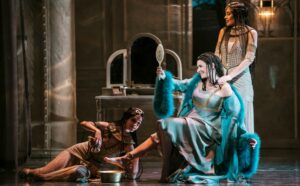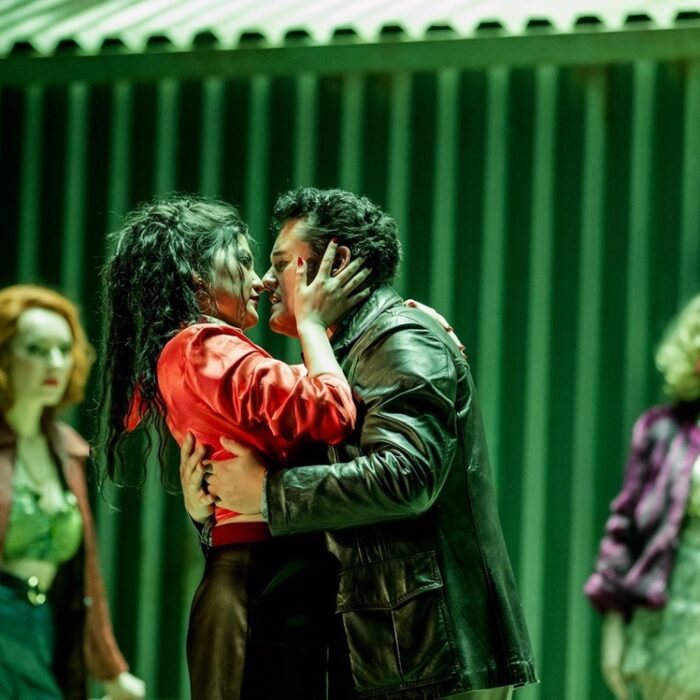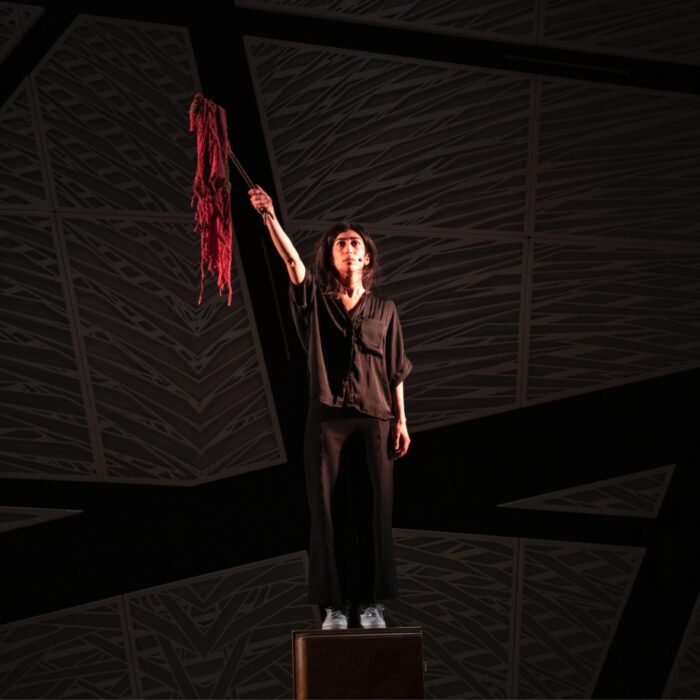
Opéra de Monte-Carlo 2024 Review: Giulio Cesare in Egitto
By Robert Adelson & Jacqueline LetzterPhoto: Marco Borrelli
On Sunday January 28th, 2024, the Opéra de Monte-Carlo gave the penultimate performance of a new production of Handel’s “Giulio Cesare in Egitto,” the third in a series of Handel productions featuring Cecilia Bartoli, following “Ariodante” in 2019 and “Alcina” in 2023, both staged by Christof Loy. This time, the staging was entrusted to Davide Livermore, scenographer Giò Forma, costume designer Mariana Fracasso and Video designer D-WOK. The production will be seen again at the Wiener Staatsoper in July.
Livermore’s inspiration for his staging is Agatha Christie’s 1937 detective novel “Death on the Nile.” Most of the action takes place on a luxurious cruise steamer named “Tolomeo” that slowly floats down the Nile, with picturesque Egyptian scenery and highly realistic waves projected on the rear of the set. The waves became more or less agitated in keeping with the spirit of the music, sometimes turning blood red after violent episodes, including bombings evocative of World War One.
Livermore’s staging was attentive both to the music and the characters’ psychological development. To reveal the characters’ schemes he sometimes resorted to humor as in Cleopatra’s Act two seduction aria “V’adoro pupille,” which was performed cabaret-style in the ship’s lounge. Gripping a microphone while the rest of the cast moves in slow motion, Bartoli as Cleopatra sings seductively inducing a dream-like feel. Taking the microphone from her hands for his next aria, countertenor Carlo Vistoli as Cesare came across as a natural nightclub singer, beginning his aria “Se in fiorito ameno prato,” with a casual “a one, two, three…” and before the return of the first section pointing to the audience and saying, in English, “and now, just for you!” Most of all Livermore supported each member of the stellar cast in instilling depth and complexity to their character.
Vistoli and Bartoli Lead a Unified Cast
In the 1724 première the role of Cesare was sung by the castrato Francesco Bernardi, known as Senesino (1686-1758). Today, this role is often sung by a woman—as is the case for the production at the Opéra de Paris production running simultaneously with that in Monte-Carlo. Vistoli’s was a virile interpretation, projecting a stronger timbre than is often the case with countertenors. His opening aria “Presti omai l’egizia terra” was cleverly staged as a smug press conference to announce his arrival in Egypt, which contrasted well with his angry “Empio, dirò, tu sei, togliti” in which his rich low register was used to good effect. It would be difficult to imagine a more impressive interpretation of “Va tacito e nascosto,” in which Cesare expresses his suspicion of Tolomeo. He began the da capo section softly, gradually gaining in strength, and concluding with a virtuosic cadenza in duo with the natural horn soloist in the orchestra. His Act three aria “Aure, deh, per pietà spirate” opened with a stunningly beautiful and very long messa di voce on the first syllable, demonstrating phenomenal breath control.
This production marks the long-awaited return of Cecilia Bartoli to the role of Cleopatra, which she sung to great acclaim in Zürich in 2005 and in Salzburg in 2012. For the first half of the performance, one did not have the impression that she in any way dominated the cast, as had been the case in the company’s “Alcina” and “Ariodante” productions. However, this equilibrium changed the instant she began her captivating Act two aria “Se pietà di me non senti.” In this number Bartoli deployed all of the vocal resources that have made her one of the greatest Handelien singers of our time. As an example of one of her wondrous moments, in the start of the da capo, she replaced the ascending interval of the main theme by a descending one, to a rich low C-sharp, giving a whole new feel to the aria.
Bartoli is above all a mature singer with deep insights into the psychology of her characters. In her next aria “Piangerò la sorte mia” she began in a sorrowful mode, but for the contrasting middle section she changed completely, becoming animated as she allowed herself to imagine revenge on her brother Tolomeo. The return to the first section was one of utter resignation, in which she attempted to strangle herself, only to be saved by her courtesans. Similarly, Cleopatra’s Act three aria “Da tempeste il legno infranto” is often sung as an upbeat expression of joy at the return of Cesare, who had been thought dead. Bartoli, however, brought out the painful ambivalence of both the text and the dramatic situation. Indeed, Cesare’s miraculous survival of his fatal leap is one of the more contrived moments of Nicola Francesco Haym’s libretto, and Bartoli’s initial rebuffing of Cesare is therefore a very human reaction. This attitude also allowed Bartoli to show the evolution of her psychological state during the course of the aria, and by the end of her final section her reconciliation with Cesare was all the more poignant.
The role of Tolomeo was conferred to Max Emanuel Cencic, whose singing was always superbly controlled, even if less dynamic than the other two countertenors with whom he shared the stage. His portrayal of Cleopatra’s brutal brother was less violent and more corrupt and sinister than some interpretations. He conveyed well his rivalry with his sister, as in his first aria “L’empio, sleale, indegno,” sung while using Cleopatra’s bedsheets as an imperial toga.
Countertenor Kangmin Justin Kim was a revelation in the role of Sesto, as his sensitive, throaty and warm voice was particularly well-matched for contralto Sara Mingardo’s Cornelia. Their duet “Son nata a lagrimar” was beautifully blended and ended in a striking pianissimo with both singers abstaining from any vibrato whatsoever. Bass-baritone Peter Kalman offered frequent comic relief in the role of Achilla. His unsuccessful seduction of Cornelia was wittily staged in his aria “Tu sei il cor di questo core,” set as a love song, introduced by putting on a scratchy old gramophone record.
This unified cast was well-supported by conductor Gianluca Capuano and his baroque orchestra Les Musiciens du Prince-Monaco. Since their inception in 2016, Les Musiciens du Prince have evolved into one of Europe’s finest period-instrument ensembles, especially in the operatic domain. The spirited ensemble playing was matched by outstanding solo contributions from solo violinist Thibault Noally for his onstage playing and comic acting during Cesare’s aria “Se in fiorito ameno prato,” and the solo horn player Ulrich Hübner in the challenging “Va tacito e nascosto.”
One of Capuano’s most unusual interpretive strategies is to have the orchestra join the singers in the practice of varying the da capo sections of each aria. Sometimes rhythms were transformed, at other times large intervals were filled in by rapid notes. In most arias, the orchestration was varied, with the addition of the positive organ or percussion instruments. Of course, since the string sections consist of several musicians playing the same part, this collective approach to embellishing da capo sections requires planning out the ornaments ahead of time, unlike the singers who are free to improvise. What is lost in spontaneity, however, is gained in variety, as the orchestra becomes an active partner in the psychological and musical evolution of each aria.
A Handelian Whodunnit
In Livermore’s “Giulio Cesare,” as in Agatha Christie’s “Death on the Nile,” the murderers are not always who we think they are. In Act three, instead of having Sesto kill Tolomeo in a straightforward manner, Livermore stages a brief duel in which Tolomeo shoots and wounds Sesto. While gloating over his act, one of his mistreated black slaves picks up Sesto’s pistol and shoots Tolomeo. An even bigger surprise came at the end of the performance. After several curtain calls to acknowledge the standing ovations, the cast gestured to the back of the stage, where a one-minute long black and white silent movie was projected. Entitled “L’Assassinio,” “The Assassination,” the film starred the cast of the production and focussed on the action that set in motion the plot of the opera: the murder of Pompeo. Was Tolomeo the murderer, as assumed? Or was it Cesare? The irreverent and improbable surprise revealed at the end was that it was Cleopatra who murdered Pompeo, to achieve her ambition of becoming Queen. A fittingly irreverent conclusion to a complex and deeply satisfying performance.



